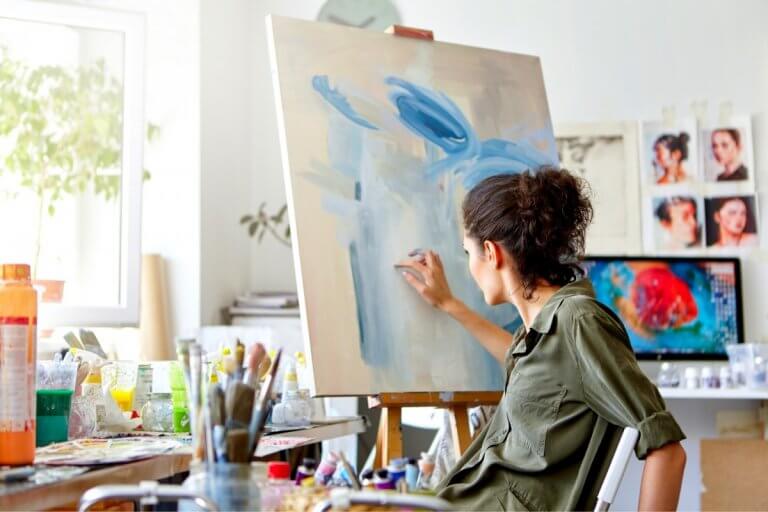
In this contemporary climate of world-class art colleges and academies, are rigid perceptions of creative education outdated?
Let’s face it – invention, design and innovation are the forces that drive ideas.
Without invention, where would the technological gadget at the tip of your fingers be right now?
Without design, how would these devices know how to serve your daily digital needs?
Without innovation, how would this article you see on your screen be possible?
Everything starts with an idea. Source: Rawpixel/Unsplash
With aims to shape the future of education, The Edge Foundation: Skills Shortages in the UK Economy provides a fresh perspective on art as an academic form of expression.
As explained in the introduction, this report “highlights how the rate of growth for both creative and STEM occupations is double the average across the economy, yet the number of school children taking GCSEs in creative and technical subjects has fallen dramatically.”
Findings state that:
– 75 percent of employers value employability skills such as communication expertise, creativity, problem solving and resilience as much as formal qualifications
– There will be an additional 119,500 creative jobs by 2024
– GCSE entries in creative subjects have fallen by 20 percent (77,000) since 2010
So, if creativity is the pinnacle of career progression, why are artistic subjects declining in schools?

Watching from the outside: Are schools alienating artistic students? Source: Igor Miske/Unsplash
In response to these challenges, Ofsted outlines how they will produce a new criteria for what constitutes an ‘outstanding’ school when it launches its consultation on a new inspection framework next year, and that schools must demonstrate excellence in creative and technical teaching if they hope to obtain that label.
With a shift in education standards, such as Ofsted’s future regulations, there may also be a shift in mindsets.
If these institutions refine their existing frameworks to better suit the talent of creative students, schools may have no choice but to improve their teaching methods and subjects in order to achieve the ‘outstanding’ award of excellence and to combat the fear of falling behind.
Why is it crucial to align arts with academics?
To respect visual learners: Not every student will fit the same learning style as their peers. Therefore, artistic subjects allow students to learn about concepts and theories in different ways. For example, designing visual flashcards may trigger a learner’s memory more than pages full of factual text.
It’s extremely therapeutic: Art therapy is a common source of expression and a progressive counselling technique. Used around the world as a way of soothing students’ concerns, art is beneficial for mental health and wellbeing.
Real-world solutions are born: Without art or design, how were the world’s most innovative solutions created? How did technology spring to life? How were climate change graphics designed to display the severity of the destruction across social media platforms worldwide?
Alternatively, in an educational sense, how did a school logos gain traction? How are playgrounds designed to stimulate integration? And how do artistic murals have the power to transform an academic community?

Art has the power to motivate learners of all abilities. Source: Guy Frutiger/Unsplash
As the bedrock of creation, art lies at the root of many award-winning colleges and academies.
LASALLE, Idyllwild and Artcenter are just a few educational institutions that treat art as an empowering source of knowledge and skill.
With high applicant rates and constant graduate turnovers, there’s obviously a great appeal in art-based schools and universities. As a way of cultivating global creativity, academic institutions like this are a true testament to the popularity of the arts.
And with so many arts-based schools out there right now, you may wonder why they made the choice to specialise in creative fields.
Perhaps they understand the demand for aspiring designers, innovators and artists and decided to tackle that need with niche courses and stimulating syllabi that reach beyond rigid and outdated learning forms.
It takes time to sculpt a masterpiece
There are many similarities between the practice of artistic and non-artistic courses.
The first is that they both take time and patience. To complete a masterpiece, whether it’s a master thesis or a master sculpture, the creator needs space to do so and inspiration to continue their work.
The second is that they both contain theory. No matter what subject, there are always underlying theories that glue the structure together. In art, there are plenty of academic theories used to depict scenery and decipher creative displays.
The third is that they both have a purpose. To regard art as a ‘false’ academic subject or a pointless academic path is naïve. Regardless of the subject you choose at school or at your future university, it will have a purpose and you will be constantly learning.
So as long as you are learning and you’re comfortable with your career path, do other people’s perceptions really matter?
In that respect, art is, and always will be, an effective academic form of expression.







